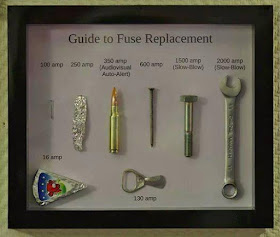In practice, Battleshort defeats safety interlocks that might keep a combat unit from completing a mission, particularly when taking heavy damage.
Below: A redneck version of Battleshort, in a civilian electrical circuit. The screwdriver should not blow under high current like a fuse would.
US Navy reactors may or may not have Battleshort capability - I'm not at liberty to say one way or another. However, there is a gross misconception about how such a system would be used. Take a look at this forum. Most of the commenters seem to have images of Star Trek's Scotty in mind, saying "She canna give no more captain! The ship's gonna break apart!!!" The scenario wouldn't be anything like that.
Let's briefly discuss Emergency Propulsion Orders. When "Ahead Flank" (or Back Emergency) is rung up, that is considered an emergency propulsion order. You are required to hit 100% forward (or reverse) propulsion speed ASAP. As you approach 100%, there will be several limiting parameters - shaft speed, ahead first stage turbine pressure, 100% reactor power, 100% steam flow, or a bearing temperature. You run up against all of these limits almost simultaneously as you finesse the throttles to coax out the last bit of speed on the ship.
What is important to understand though, is that exceeding any of these parameters will not lead to a substantial improvement in ship speed. At best, you might get a couple of knots of extra speed, and only for a
minute or two - before losing propulsion completely due to damaging something. Losing propulsion is
not a winning strategy in battle.
The purpose of Battleshort is *not* to boost the output of the propulsion plant.
The purpose of Battleshort is to keep the ship's propulsion system in service - even if there is flooding, electrical shorts of grounds, instrumentation failures, reduction of coolant flow, overheating, etc - in order for the ship and crew to survive battle damage. It's NOT the nuclear reactor version of nitrous.
So when would you in theory use a Battleshort circuit? Well, that would be up to the commanding officer of the ship, and would not a decision to be taken lightly. By the time a ship begins taking heavy damage, it might be too late to take preventative measures. Maybe the skipper would want to enable Battleshort prior to entering an area where damage was likely.
Going to Battleshort would remove all automatic protective circuitry, and at that point you would be relying solely on human intervention(s) for continued operation under possible abnormal conditions and for nuclear safety - basically reactor core damage.
To my knowledge only one ship, a British nuclear submarine, has ever used Battleshort - HMS Sceptre (S104). In the Barens Sea, in May 1981, Sceptre collided with a Soviet Delta III class submarine, the K-211. HMS Sceptre suffered a reactor scram following the collision and apparently the crew needed to place the reactor protective circuitry into Battleshort in order to conduct a re-start.



No comments:
Post a Comment